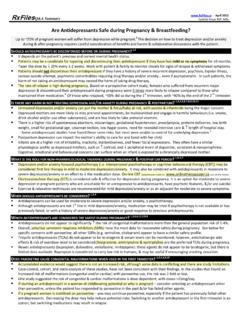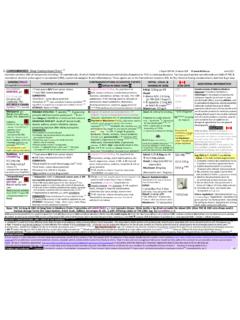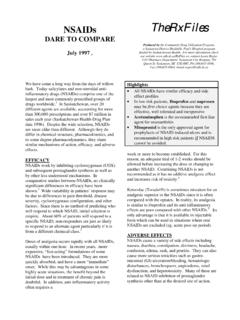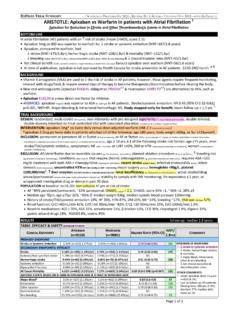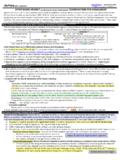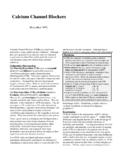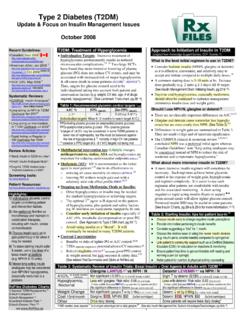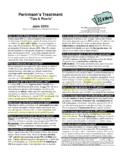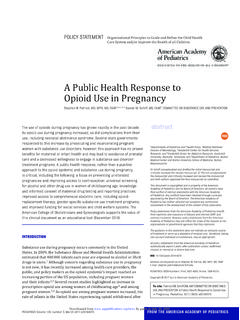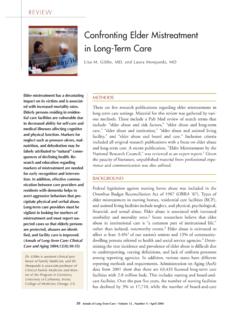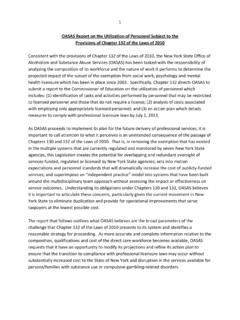Transcription of SUBSTANCE ABUSE: Overview and Treatment …
1 SUBSTANCE abuse /ADDICTION: Overview & Treatment Considerations For refs/updates/extra info: L Regier BSP BA Mar 2017. 1) Definitions 3) Alcohol (EtOH) See also Alcohol Use Disorder chart, pg 185-186. 1. Spectrum of severity: use misuse abuse - dependence 4) Addiction Screening: CAGE, AUDIT, Other SASSI 9. Misuse: sporadic use without apparent adverse consequence; wilful or unintentional EtOH is a leading cause of serious injury, accidental death, birth defects C have you ever felt the need to Cut down or Change your drinking/drug use? abuse : frequency of consumption may vary; some adverse consequences A standard drink = grams ( ounces) of pure alcohol or: A do you get Annoyed when others criticize your drinking/drug use? or clinical impairments are experienced by user (dominos begin to fall) - 12-ounces 341mL of regular beer (5% EtOH) G have you ever felt Guilty about your drinking/drug use for any reason?
2 Addiction's 4Cs: LOSS of control over SUBSTANCE use WITH craving &/or - 5-ounces 142mL of wine (12% EtOH) E Eye-opener: Have you ever felt the need for a drink early in the morning compulsive use which is continued despite harm. (major domino effect) - or a shot of 80-proof (40% EtOH) distilled spirits or liquor to decrease hangover or withdrawal? ( gin, rum, vodka, or whiskey). When assessing a patient's answers to the above questions: one YES. Pseudoaddiction: drug seeking behaviour mimicking addiction resulting suggests caution; 2 YES suggests strong caution/need for vigilance. from under- Treatment of pain. {But r/o pain + addiction, dual diagnosis.} [Also significant caloric intake!!! ] ------------------------------------ Low-risk drinking CAMH = describes a lower long-term risk pattern. AUDIT: 10 questions to assess alcohol use 0 1 2 3 4.
3 ----- ---- --- ---- ---- --- ---- --- ---- ---- --- ---- ---- --- ---- ---- --- ---- --- ---- ---- --- ---- ---- --- ---- ---- --- ---- ---- --- ---- --- ---- ---- --- ---- - Dependence, physical: a state of adaptation resulting in drug class- specific withdrawal symptoms upon abrupt dose reduction, decreasing - In any one day: no more than 2 drinks for ; no more than 3 for . 1) How often do you have 1 drink containing alcohol? Never monthly 2-4x/mo 2-3x/wk 4+x/wk & no more than 10 drinks per week for ; 15 drinks per week for . 2) How many drinks do you have on a typical day? 1-2 3-4 5-6 7-9 10+. drug levels or antagonist administration. (Not to be confused with addiction!) - ; 3) How often do you have 4+ drinks on one occasion? Never < 1/mo 1/mo 1/wk ~ daily Detoxification-managing acute withdrawal: Treatment intended to Those who should not drink: 4) How often last year were you not able to stop drinking?
4 Never < 1/mo 1/mo 1/wk ~ daily 5) How often last year did you fail to do what was expected? < 1/mo 1/mo 1/wk ~ daily remove the physiological effects of the addictive substances (protocols) - Children, adolescents; individuals of any age who cannot limit their drinking. Never 6) How often last year have you needed a drink in the morning? Never < 1/mo 1/mo 1/wk ~ daily - Social Detox: managed & engaged in recovery; 3-10 day stay. - Pregnancy: risk of FAS with heavy drinking. Pre-conception: limit intake. 7) How often last year have you had a feeling of guilt after drinking? Never < 1/mo 1/mo 1/wk ~ daily - Brief Detox: ~24 hour observation; not medically managed. - Individuals who plan to drive, operate machinery, or take part in other 8) How often last year have you not remembered the night before? Never < 1/mo 1/mo 1/wk ~ daily Harm Reduction: measures taken to address problems ( social) activities that require attention, skill, or coordination.
5 9) Have you/someone else been injured as a result of drinking? No Yes, not Yes, 10) Has a relative, friend or doctor been concerned about your drinking? No this yr. this yr without necessarily requiring abstinence or cessation of drug use - Those at high risk of DI's: Rx or OTC drugs disulfiram, metronidazole, CNS depressants? Total score: 0-7=low risk; 8-15=at risk; >16 likely problems Tolerance: effect of a drug over time, or dose required for same effect Precaution also in those with chronic/high-dose acetaminophen use. Single Question Screen: How many times in the past year have you had x or more Tolerance & physical dependence should not be confused with - Individuals with certain medical conditions pancreatitis, cirrhosis, hepatitis? drinks in a day? (where x = 4 drinks for , & 5 drinks for ). addiction. Addiction is characterized by compulsive use of a SUBSTANCE - Persons recovering from alcoholism, or having family hx of alcoholism.
6 (How many times in the past year have you used an illegal drug or used a prescription med for nonmedical reasons?). or preoccupation with obtaining it despite evidence that continued use Binge drinking: a consumption pattern that brings the blood EtOH History (Useful questions asked in a non-judgemental fashion): causes harm (physical, emotional, social &/or economic) 2 level to & 's short term risk! Corresponds to 5 drinks on one Ask 1st about socially acceptable drugs: nicotine, caffeine. 3 occasion for ; or 4 /single occasion for , generally within about 2 hours. Ask next about alcohol, specifically beer quantity used. 2) Statistics From the Literature (CADUMS 2011/2012) Then ask about illicit drugs; begin with marijuana. Don't rely on intuition when screening! The prevalence of past 12 month cocaine ( ), ecstasy ( ), speed ( ) Related: maltreatment of others ( caregiver child abuse ; intimate partner violence) 7 Are illicit drugs available at school/work?
7 Any close friends who use drugs? and methamphetamine ( 2008) comparable to rates reported in 2004. Psychosocial issues: escape , depression, self-esteem, suicidal ideation Obtain collateral information from family & friends as necessary;. The rate of drug use cocaine or crack, speed, ecstasy, hallucinogens (including salvia) or heroin by High risk behaviours: sexual ( abuse , unplanned/unwanted/unprotected), youth 15-24 yrs is much higher ( ) than reported by adults 25 yrs ( ). confirm patient history & assess for recent/sudden behaviour changes. The overall rate of psychoactive drug use, including opioids was ~ 24% for >15yrs. financial, criminal; driving with intoxicated driver; cutting & suicide attempts Ask regarding weight loss, sleep disturbance, impotence, gambling, porn. ------------------------------------ indicated they had abused such drug.
8 Overdose/death with Adolescents: especially vulnerable (neurodevelopment & behaviour)8 Physical findings (intoxication or withdrawal): 72% of non-medical opioids used by students were obtained from home 4 Problems: health, inhibition/violence/aggression, ca, impaired driving Evidence of associated infections, hepatitis, HIV, oral thrush The prevalence of harm 4x higher among youth aged 15 to 24 yrs ( ) than adults Recovery must be functional not just stopping or decreasing use { Needle marks (including hidden sites), STDs; pupil size, HR, sweating, aged 25+ yrs ( ). {Age adjusted mortality 5x in urban drug addicts Boston 5} identify life skills lacking & move client toward achieving/functioning.} watery eyes, runny nose, slurred speech, yawning, unsteady gait. {Harm related to social life, health, work, studies, or employment, financial, legal, housing or learning.}
9 }. Toxic Alcohols methanol: look for; contact poison centre re. management Lab: LFTs, HBV/HCV screen; drug screens ( UDT as at bottom of page). ~10% report drugs/alcohol as reason for 1st ever sexual intercourse 6. 5) Universal Precautions - Opioid Pain Medicine 11,12,13 6) Red Flags Aberrant Rx Drug Use 16,17 7) Principles of Addiction Treatment 18. Assumes that one cannot always determine who will become a problem Consider Discontinuation / Specialist Referral if 1) No single Treatment is appropriate for all; concomitant medications opioid user; thus, suggests a minimum level to assess & manage risk. 1. Prescriptions from multiple physicians (check profile when available) are useful for many; Treatment needs to be readily available 1. Make a diagnosis with appropriate differential {pain = sensory & emotional} 2. Frequent visits to emergency room requesting drugs of abuse 2) Attending to multiple needs, not just drug use, only way for success 2.
10 Psychological Assessment Including Risk of Addictive Disorders; 3. Requests from patients from outside local area! Check picture ID! 3) Assess for medical, family, vocational, social & legal services Coping issues. Include discussion of urine drug testing (UDT) 4. Stolen, modification or tampering of prescriptions 4) Ensure adequate time in Treatment ( 3 months). 3. Informed Consent &/or use of a Treatment Agreement (samples14) 5. Polypharmacy with CNS depressants, habituating substances 6. Forgery, selling, stealing, or using other persons medications 5) Arrange for counselling & behavioural tx individual or group Life worth 4. Pre/Post-Intervention Assessment of Pain & Function 6) Integrate Treatment for those with mental disorders 7. Injecting oral or chewing long-acting formulations living, 5. Appropriate Trial of Opioid Therapy +/- Adjuncts +/- Non-drug Tx 7) Acute detoxification is only the 1st stage in long-term tx 6.
